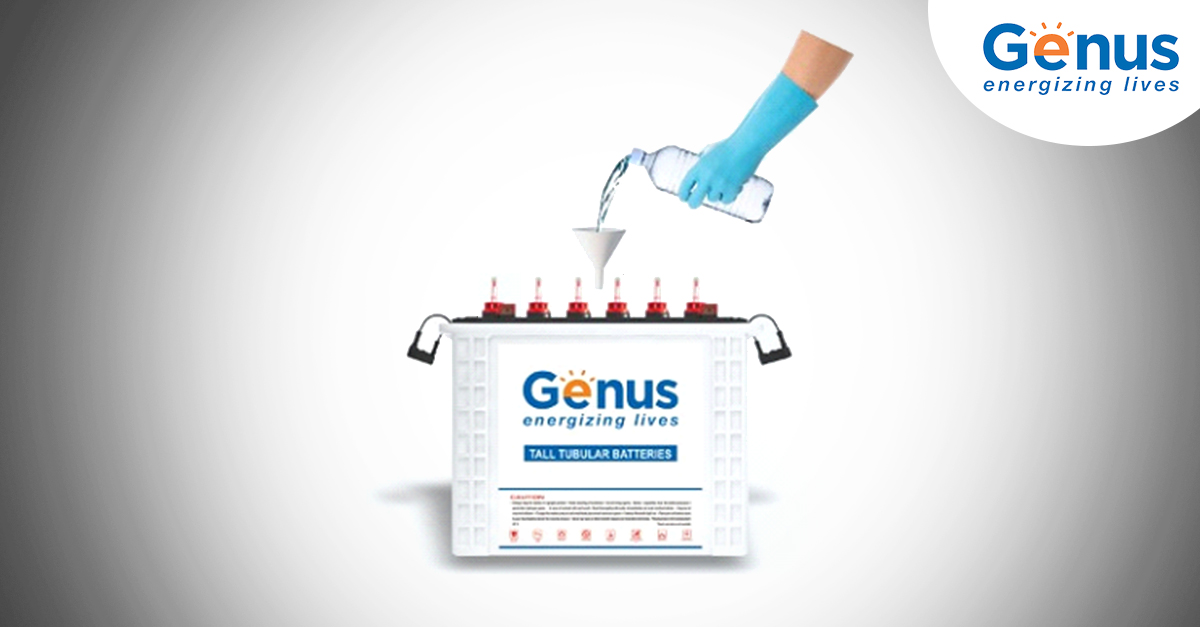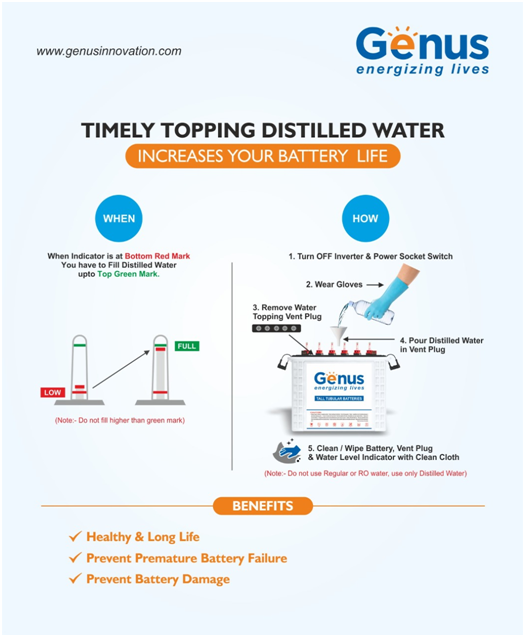
What keeps your home powered up every time and never lets you down? It is your inverter that keeps working silently and is always there through unexpected outages to keep your home powered up. So it is taking good care of you and your home with the desired power backup. But are you also doing your part and taking care of your inverter?
If your choice is a tubular battery then it is important to understand that regular maintenance is a responsibility and not a choice. One of the most important yet ignored parts of this maintenance is topping up the battery with distilled water at regular intervals.
So today we are going to simplify this process for you. Whether you are doing it for the very first time or are an existing user of tubular battery inverters, this blog will provide the step-by-step guide to you. You will also be able to understand why it is important and matters for the comfort of your family and your battery’s health.
Why does your inverter battery need water?
Inverters power your devices by converting the DC current into AC current and there is a chain of chemical reactions behind this process. Since the electrolyte solution (acid + distilled water) is involved in this process, they do not achieve the maximum capacity consistently. Over time, the water evaporates and the acid becomes concentrated as the acid-water balance is not optimal.
Therefore it is essential to keep the water level topped off in the inverter always so that the acid remains diluted enough and does not lose its efficiency over time. It is important to note that if the water levels drop too low:
- The backup capacity weakens
- The battery life reduces
- Battery plates get permanently damaged
- There is risk of overheating
- The safety issue also increases
So always remember: Regular top-up = Long lasting power and peace of mind.
Another important factor to consider for inverter water top-up is that we should not use just any water for the battery. It is advised that only distilled water should be used for batteries. Why is distilled water used? Let us explore this further.
Why use distilled water for inverter batteries?
Distilled water is the purest form of water and it is so pure that even the regular water ions are not there in it. This nature of distilled water makes it useful for many purposes including replenishing the inverter and car batteries, medicine applications etc.
If the regular water is used in inverter batteries then water ions will form a layer and clog the electrodes. They will also hinder the current producing chemical reactions along with the other dust particles and organic compounds that are present in regular water.
These ions are not present in regular water and therefore the electrodes remain free from any problems. This is the reason why it is always advised to use only distilled water for topping-up the inverter battery.
Also Read: Things You Need for Your Grid-Tied Solar Plus Battery Back-Up System
Steps to top-up water in inverter battery:
Before you begin, make sure that the inverter is turned-off, safety is the topmost priority.
Check if the battery needs top-up
- Open the battery cover carefully and check the level of distilled water with the help of water level indications. The lower level has a red mark while the upper level has a green mark.
- If the level is indicated by a red mark then it is time to top-up.
Remove the vent plugs of water topping
- Twist it in an anticlockwise direction to open and wipe off the dust around the area using a dry and clean cloth.
- Use a funnel to place in the hole and pour distilled water slowly into the chamber.
- Repeat this for each chamber till it reaches the Max level (or Green mark and not beyond that).
- Prevent overfill else it might lead to acid spills and leakage.
Close the vents
- Once water topping is done, close the vent plugs carefully by twisting it in clockwise direction.
- Repeat the process for all the chambers.
- Wipe any acid residue/ water with the help of a clean cloth on the battery surface.
Once you are done with filling in the distilled water in all the chambers and have closed them all properly, turn the power back on.

Important Do’s and Don’ts of inverter battery water top-up:
Do’s
- Make use of distilled water only for topping up the inverter battery
- Make sure to check the distilled water level in battery on monthly basis
- While filling distilled water in the battery, make sure that you are wearing gloves
- Set a reminder at regular intervals to get timely notifications about the water levels in battery
Don’ts
- Do not use anything other than the distilled water in battery
- Never top-up when the inverter is either charging or is on
- Avoid overfilling or under-filling the water than the marked level
- Do not use dirty tools and also do not touch inside the cells
- Don’t use area that is not ventilated properly for topping-up
How often do you need to top-up inverter battery water?
This thing depends on some of the important factors like:
- Power cuts in your area
- Type of battery that you are using
- Weather ( it is more frequent in the summer season)
Note: Remember to check the levels every 2-3 months to avoid any problems.
What is the importance of topping-up water in an inverter battery?
An inverter is the device that takes care of the comfort and safety of your family every time there is a power outage. Whether it is your child preparing for an exam, your parents resting peacefully or you are simply enjoying dinner time with your family, an uninterrupted power supply is very important during these important moments to keep them going.
If you ignore topping-up water in the inverter battery, it might affect:
- The backup duration
- Lifespan of your battery
- Your budget
- Peace of mind of your loved ones
Tip: Taking 15 minutes today might save you from the stress of tomorrow
Also Read: 5 Tips to Plan Ahead for Power Cuts this Summer
Inverter battery water top-up quick checklist:
| Do This | Don’t do this |
| Turn off the inverter | Top-up while the inverter is on or charging |
| Use distilled water only | Use mineral or tap water |
| Fill up to the MAX level only | Overfill beyond MAX level |
| Maintain cleanliness and wear gloves | Use dirty hands/tools |
| Check every 2-3 months | Wait until the backup of battery drops |
Conclusion: Show some care to the one who takes care of the comfort of your family
Inverter serves to be an important appliance of your home especially if you live in an area that is prone to power cuts. Your inverter battery works behind the scenes silently and offers uninterrupted power during outages. So it deserves the slight attention – just like the other appliances of home. A simple water top-up with distilled water makes the difference between total blackout and light on during emergencies.
So next time when you notice the MIN level (or level reaching RED mark), don’t ignore it but act on it.
